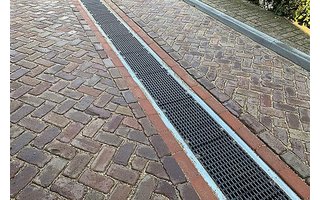You have no items in your shopping cart
Self-supporting concrete drain channels type I
Self-supporting concrete drainage channels
Self-supporting concrete drainage channels offer several advantages over traditional drainage channels. Firstly, they have a high load-bearing capacity, which means they can withstand heavy loads. This makes them ideal for applications involving high traffic or heavy vehicles, such as parking lots and industrial environments. In addition, self-supporting concrete drain channels have a long lifespan. Concrete is a durable material that resists wear and corrosion, meaning the gutters will last a long time without requiring much maintenance. Another advantage of self-supporting concrete drains is that they are aesthetically pleasing. They can be customized to suit the environment and can be colored or stamped to blend seamlessly into the landscape. This makes them not only functional, but also visually attractive. In short, self-supporting concrete drain channels offer a combination of high load-bearing capacity, long service life, resistance to heavy loads and aesthetic appeal, making them an excellent choice for a variety of applications.
Applications of self-supporting concrete drain channels
Self-supporting concrete drainage channels find various applications in different sectors. One of the most important applications is in parking lots, where these gutters ensure efficient drainage of rainwater and prevent flooding. In addition, self-supporting concrete drainage channels are also widely used along roads and highways, where they help drain rainwater and prevent aquaplaning. These gutters are used on industrial estates to direct rainwater away from company buildings and storage areas, creating a safe working environment. Self-supporting concrete drainage channels also play an important role at airports, because they ensure good drainage for runways, taxiways and aircraft parking areas. Finally, these gutters are also used on port areas, where they help drain rainwater and prevent damage to ships and quays. All in all, self-supporting concrete drains are indispensable in various sectors and contribute to the safe and efficient drainage of rainwater.
Construction and design of self-supporting concrete drainage channels
The construction and design of self-supporting concrete drainage channels are of great importance for the efficient drainage of water. To ensure that the drains are self-supporting, the correct materials and thickness must be used. Concrete is a commonly used material because of its durability and strength. The thickness of the drainage channels depends on the load to which they are exposed. In addition, the width and depth of the drainage channels are important to provide sufficient water drainage capacity. Various techniques can be used to strengthen the self-supporting properties of the drain channels. A commonly used technique is the use of reinforcement in the concrete structure. This increases the strength and stiffness of the drains, making them more resistant to loads. In addition, pre-stressed concrete drain channels can also be used, where the concrete structure is put under tension in advance. This provides extra stability and load-bearing capacity. In addition to the construction and strengthening techniques, the design and finish of the drain channels is also important. The design must ensure efficient water drainage and prevent dirt from accumulating. That is why self-supporting concrete drains often have a U-shaped profile, which ensures optimal water flow and minimizes the risk of blockages. In addition, the finish of the drain channels can be adapted to the specific environment, for example by adding an anti-slip coating for extra safety. Finally, it is important that the self-supporting concrete drain channels meet the required load and load-bearing capacity. Depending on the application, different loads may occur, such as traffic loads or loads due to water flows. Therefore, the drainage channels must be designed and constructed to withstand these loads and provide the required load-bearing capacity. This can be achieved by applying proper sizing and strengthening techniques. In short, several aspects must be taken into consideration in the construction and design of self-supporting concrete drainage channels. The choice of materials and thickness, the width and depth, the reinforcement techniques, the design and finish, as well as the load and load-bearing capacity all play a crucial role in creating durable and efficient drains. With the right approach, self-supporting concrete drains can provide safe and effective drainage of water.
Maintenance and cleaning of self-supporting concrete drain channels
To ensure that self-supporting concrete drains continue to function optimally, regular inspection is essential. Pay attention to any blockages or damage. If dirt and debris accumulate in the gutter, it is necessary to remove it. This can be done by manually removing the dirt from the gutter. It is then important to clean the drains thoroughly with water and a brush. Using this method can effectively remove any debris that may have adhered to the gutter. Cleaning of the drains should be carried out regularly to prevent blockages and to ensure the proper functioning of the gutters.
Sustainability and environmental friendliness of self-supporting concrete drainage channels
Self-supporting concrete drainage channels are a sustainable and environmentally friendly solution for draining water. These gutters have a long lifespan, making them a cost-effective choice in the long term. They require little maintenance, which saves both time and money. In addition, these gutters help reduce flooding by effectively draining rainwater and preventing it from accumulating on roads and paths. This is not only beneficial for infrastructure, but also for the environment, as it helps prevent damage to roads and buildings. In addition, self-supporting concrete drains contribute to protecting the environment because they are made of a natural material, namely concrete. Concrete is recyclable and can be reused, reducing its impact on the environment. In short, self-supporting concrete drains provide a sustainable and environmentally friendly solution for draining water and protecting the environment.




